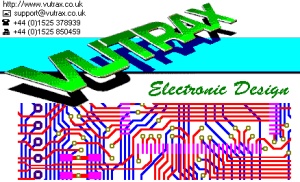 |
       |
Vutrax Basic Training tutorial part 1
The Structure of Vutrax: Version 12a.
Vutrax has 5 modes of operation:
Schematic, Drawing, Footprint Library, Symbol Library, & PCB. with 31 layers. Althought it runs under Windows, it is still a command line based system. It is also a Vector based pagage.
Set-up the libraries.
File format *.DGM, Mode Schematic:
First, in order to be able to read the library files, the system must be set-up to read the files from their location on the hard drive.
Schematic symbols. Go to, Tools > Library > Schematic Index.
Locate the files that you need from this menu then click RUN. This will create an index file called SCHEMLIB.LIX.
PCB footprints:
Go to Tools > Library > Rats Nest Index.
Locate the files that you need from this menu then click RUN. This will create an index file called FOOTLIB.LIX.
Objects. (Power rails, Ground symbols etc…)
Objects can be kept in any *.LOG file as long as they have the Object Attribute attached.
Go to Tools > Library > Object Index.
Locate the files that you need from this menu then click RUN. This will create an index file called OBJLIB.LIX.
Start a Schematic.
First set-up a project folder:
Then open or create a new file.
Start with a company Boarder. You can make one from scratch or “Merge” one in from another design.
Goto “File > Merge > Schematic or Board Profile”.
Import parts:
To start bringing in parts, goto the toolbar button that looks like a Text icon (5th from right). This is the Index List button.
Click it & use the filter to find parts. EG. For all resisters type R*
Connecting parts:
Connect parts together using the “Start line” icon (Green triangle, near the centre).
Aim for the pink squares / diamonds to connect. When your finished hit the End key or Right click & click Cancel.
NOTE: When a good connection has been made, it turns Green, when its not connected it turns Blue.
Add global signals:
Goto Symbol > Retrieve > From Object List… & use the filter to find signals.
Signal Names:
To add signal names click the Signal Name button (4th right). This is used to add names to drawn lines.
To add signal directly to open pins, use the Label button (3rd right).
Values:
If a part has a # symbol, then you can assign a value to it. Goto the “Part Value” button (2nd right), enter a value, click OK then aim for the # on the part.
Reference names:
To add Reference names to parts e.g R1, goto the “Silkscreen names” button (1st right, the one with XXX), click & type in your reference, click OK then aim for the XXX on the part.
Net List:
When the schematic is completed a net list (or in Vutrax terms) Wire list needs to be created, (*.WIR).
Goto, Analyse > Analyse Circuit. Click OK & then read the summary. If there are 0 errors then you can proceed to the Job Library & Rats nest stage. If you have errors, then you must go back to the schematic & correct them first.
 |
|---|
These tutorials assume that the user is familiar with basic PCB design knowledge.
Contact us for availability.
For On or Off site assistance with your PCB
layout design call +44(0)7715 507855
Associated sites:
DCB Automation - Automatic
Optical Inspection for PCB assemblies.
Vivace Lighting - Luminus Products Ltd. LED lighting for architectural, constructional applications, hospitality, commercial and outdoor market places.
| Home | Contact | Profile | Resources | Cadstar | Pads Layout | Pads Logic | Pulsonix | Vutrax | © PCBDEN 2010 |